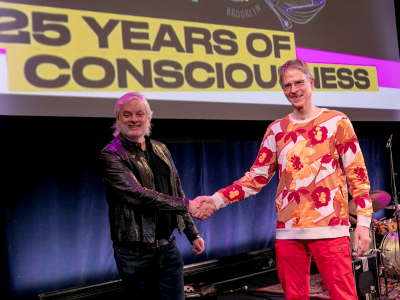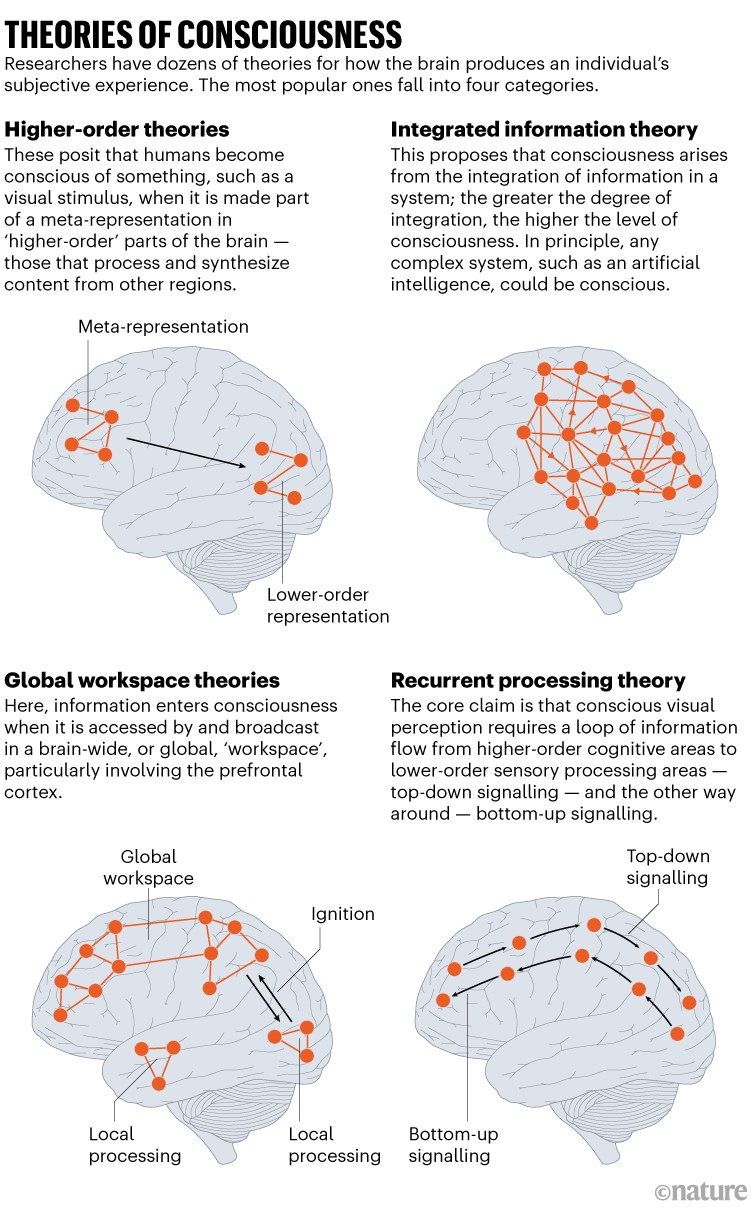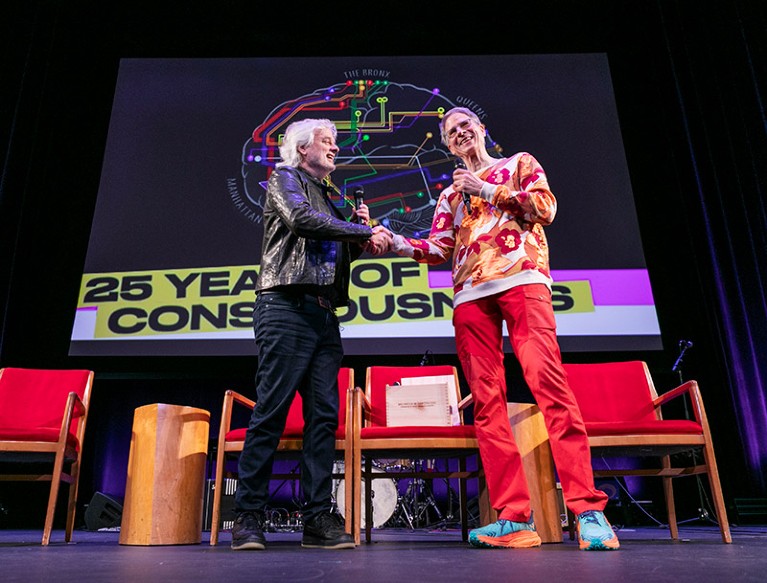Guerra de conciencias: ¿podrán ponerse de acuerdo los científicos sobre el funcionamiento de la mente?
Hay docenas de teorías sobre cómo el cerebro produce la experiencia consciente, y un nuevo tipo de estudio está poniendo a prueba algunas de ellas.
La neurocientífica Lucia Melloni no esperaba que le recordaran el divorcio de sus padres cuando asistió a una reunión sobre la investigación de la conciencia en 2018. Pero, al igual que sus padres, los académicos reunidos no se ponían de acuerdo en nada.
El grupo de neurocientíficos y filósofos se había reunido en el Instituto Allen para la Ciencia del Cerebro en Seattle, Washington, para idear una manera de probar empíricamente teorías de la conciencia que compiten entre sí: un proceso llamado colaboración adversarial.
Idear un experimento asesino era complicado. "Por supuesto, cada uno de ellos proponía experimentos de los que ya conocían los resultados esperados", explica Melloni, que dirigió la colaboración y trabaja en el Instituto Max Planck de Estética Empírica de Fráncfort (Alemania). Melloni, recurriendo a su papel de niña, se convirtió en la intermediaria.
https://www.nature.com/articles/d41586-024-00107-7?utm_medium=Social&utm_campaign=nature&utm_source=Twitter#Echobox=1705492433-1
The collaboration Melloni is leading is one of five launched by the Templeton World Charity Foundation, a philanthropic organization based in Nassau, the Bahamas. The charity funds research into topics such as spirituality, polarization and religion; in 2019, it committed US$20 million to the five projects.
The aim of each collaboration is to move consciousness research forward by getting scientists to produce evidence that supports one theory and falsifies the predictions of another. Melloni’s group is testing two prominent ideas: integrated information theory (IIT), which claims that consciousness amounts to the degree of ‘integrated information’ generated by a system such as the human brain; and global neuronal workspace theory (GNWT), which claims that mental content, such as perceptions and thoughts, becomes conscious when the information is broadcast across the brain through a specialized network, or workspace. She and her co-leaders had to mediate between the main theorists, and seldom invited them into the same room.
Their struggle to get the collaboration off the ground is mirrored in wider fractures in the field.
One problem is that consciousness means different things to different people. For example, some researchers focus on the subjective experience — what it is like to be you or me. Others study its function — cognitive processes and behaviours enabled by being conscious. These differences muddy attempts to compare ideas.
And then there was the open letter. Last September, more than 100 researchers signed a letter, posted as a preprint, that critiqued IIT, arguing that its predictions are untestable and labelling it as pseudoscience1. The letter was posted just after Melloni’s collaboration released its results.

Consciousness theory slammed as ‘pseudoscience’ — sparking uproar
Chaos ensued. The letter provoked blowback from other scientists who felt that such an attack could aggravate divides and hurt the field’s credibility. Signatories reported receiving ominous e-mails containing veiled threats. Researchers on both sides of the aisle lost sleep over accusatory tweets. Some even contemplated leaving science altogether.
Younger researchers are particularly worried about the contentious climate. They fear that a field engulfed in such angry disputes could be perceived externally as being stuck, which could affect funding, says Johannes Kleiner, a mathematician studying consciousness at the Ludwig Maximilian University of Munich in Germany.
But despite these challenges, many have hope for the future of consciousness science. Leaders of the adversarial collaborations say that their model is already helping to advance the field, even if in small steps. And they are not the only ones conducting highly regarded, empirical tests of consciousness theories. Over the past two decades, there have been hundreds of such experiments, a sign of the field’s growing maturity.
Other research funders are focusing attention on the topic, too: last June, the US National Institutes of Health convened a three-day meeting on frontiers in consciousness research.
And a fresh generation of researchers is leading efforts to cultivate meaningful dialogue and open-mindedness. “Instead of competing, we should understand that science is a team effort,” says neuroscientist Rony Hirschhorn at Tel Aviv University in Israel. “It may be naive, but this is my way of optimism: to hope that we are better than that.”
Striving for legitimacy
There are dozens of theories of how our brains produce subjective experiences, and good reasons besides philosophical interest to want to understand the problem more fully. In medicine, for instance, it could help to diagnose awareness in people who are unresponsive; in artificial intelligence, it might help researchers to understand what it would take for machines to become conscious.
But for many years, consciousness was not seen as a serious scientific topic. “Until about 30 years ago, it was taboo to study consciousness, and for good reasons,” says Lenore Blum, a theoretical computer scientist at Carnegie Mellon University in Pittsburgh, Pennsylvania, who is president of the Association for Mathematical Consciousness Science, based in Munich. Back then, she says, there weren’t good techniques to study consciousness in a non-invasive way.

Decades-long bet on consciousness ends — and it’s philosopher 1, neuroscientist
In 1990 — around the time when the brain-scanning technique functional magnetic resonance imaging emerged — an influential paper helped to change the field’s reputation. Nobel-laureate biologist Francis Crick and neuroscientist Christof Koch, now at the Allen Institute for Brain Science, wrote that the moment was “ripe for an attack on the neural basis of consciousness”2.
Since then, philosophers and neuroscientists have proposed multiple theories to explain the physical basis of the subjective experience — referred to as the “hard problem of consciousness” — and of the “easy problems” such as attention and wakefulness3. In an unpublished effort to count them, Jonathan Mason, a mathematician based in Oxford, UK, identified more than 30 theories.
A handful of theories have been particularly influential (see ‘Theories of consciousness’). They include the two that Melloni is helping to test: IIT, proposed by Giulio Tononi, a neuroscientist at the University of Wisconsin–Madison, and GNWT, the brainchild of Stanislas Dehaene, director of the Cognitive Neuroimaging Unit at INSERM-CEA in Gif-sur-Yvette, France.

Source: A. K. Seth & T. Bayne Nature Rev. Neurosci. 23, 439–452 (2022)
Other front runners include a group of ideas called higher-order theories (HOT), which propose that, for content to be consciously experienced, it must be synthesized into a meta-representation in higher-order brain areas. Another prominent concept is recurrent processing theory (RPT), which suggests that consciousness requires a loop of information flow and feedback. It has been studied mostly in the brain’s visual areas, but the same idea should apply to other senses such as hearing or smell.
Empirical studies testing the predictions of such theories are becoming more rigorous and sophisticated, but — as often happens in science — many are conducted by researchers affiliated with the very ideas they are testing, making them prone to confirmation bias, says Hirschhorn. As a result, she says, theories have been evolving in isolation.
“For the past 30 years, you have had some dominant theories that, when challenging results show up, they revise the theory to accommodate these new findings,” says Biyu He, a neuroscientist at New York University Grossman School of Medicine in New York City. In that sense, the adversarial collaborations are shaking up the field, says He, who is leading another such collaboration, testing RPT and two versions of HOT.
Proponents of some prominent theories have sometimes made the tests more adversarial than collaborative, according to some of the scientists leading the studies. This doesn’t apply to all the collaborations, says He, and depends to some extent on how easy the theories are to compare to one another. But some theorists are described as having big personalities; notably, most of them are men. “I don’t think that’s because women are not doing important research,” says He. “I think that’s mostly because certain people are more willing to come out and talk about big grand theories.”
A crash course in diplomacy
Neuroscientist Liad Mudrik at Tel Aviv University remembers how excited she was to attend the Seattle meeting that resulted in the collaboration between IIT and GNWT, dubbed Cogitate. “I was writing down everything that people were saying and I was super excited about the entire process,” she says.
During her flight back home to Israel, after being designated as a project co-leader, she drafted an experimental design based on the discussions and quickly sent it to her colleagues. “I was so naive at the time,” she says. From that moment until they actually nailed it would be ten months.
After wrangling over which aspects of consciousness the team would look for and with which methods, the researchers eventually settled on two experiments — one preferred by each competing theorist. The team developed a list of predictions from each theory of what would be observed in participants’ brains as they underwent three types of brain scan. The researchers also agreed on what would be considered a pass or a fail for each theory in each task.

At an event in New York City in June, neuroscientist Christof Koch (right) lost his 25-year-old bet with philosopher David Chalmers that science would crack the neural correlates of consciousness by 2023.Credit: Jesse Winter for Nature
In the first experiment, participants were shown a series of pictures and symbols and asked to report when certain images appeared.
According to IIT, the task should prompt sustained activation in the back of the brain, which is what the data suggested. However, there was only transient synchronization of activity between brain areas in the posterior cortex, not the sustained synchronization that was hypothesized.
GNWT predicted that the prefrontal cortex should be activated during the task — something the team confirmed. But there was no evidence that the region contained information about the orientation of the object, which is part of the conscious experience and would be expected according to the theory. The experiment also found evidence of the global broadcasting postulated by GNWT, but only at the beginning of an experience — not also at the end, as had been predicted. Results from this first experiment were made public in a preprint last year4.
The second experiment, for which results haven’t yet been made public, involved participants playing a video game and being asked whether they were aware of certain images shown on the background of the screen.
Having two experiments was a compromise that the team had to make to facilitate consensus between the Tononi and Dehaene camps. “I really admire both of them and I think they are extremely good scientists,” says Melloni. But, she adds, “the world would be a better place if they could give themselves a chance to listen to each other”. Tononi says that the adversarial collaboration allowed him to see the other theories more clearly. (Dehaene did not respond to Nature’s request for comment.)
Another diplomatic strategy was to engage with the two theorists in separate conversations, ‘translating’ the ideas from one to the other. “One of the key roles that we have,” says Mudrik, “is to find a common language to make sure that we’re talking about the same thing.”
Tononi acknowledges how hard the project has been and praises the study leaders — Melloni, Mudrik and Michael Pitts, a psychologist at Reed College in Portland, Oregon — for pulling it off. “They invested so much of their time and passion, rather than doing their own experiments,” he says. “They did a fantastic job.”
Caught in the crossfire
Younger scientists are particularly keen to find common ground.
During his first PhD, in mathematical quantum field theory, Kleiner felt frustrated by the infighting among senior scientists. “From the outside, the field was just perceived as not making good progress because everyone was so vocal about other approaches being wrong,” he says.

Decoding the neuroscience of consciousness
When he decided to do a second PhD, this time in consciousness research, he was aware of existing tensions in the field, but felt that people generally got along well. The community felt hopeful about the potential of the adversarial collaborations to produce useful data, he says. The open letter shattered those hopes. Deeply unsettled by the harsh online interactions, Kleiner was determined to do something. He didn’t want his new field to be perceived the same way as his first. “I know this sounds totally naive, but if you can’t heal this division, then so many negative things follow.”
After the letter came out, Kleiner helped to organize an online event to discuss the future of consciousness science, under the banner of the Association for Mathematical Consciousness Science, which he co-founded in 2021. But the proposition backfired, with some people in the community perceiving it as one-sided. After much thought, the format of the event changed to a ‘virtual coffee and open conversation’ in which participants were urged not to mention the open letter directly.
Another organization aiming to help the field break out of its silos is the Mediterranean Society for Consciousness Science, which aims to stimulate deep conversations between scholars from different schools of thought. Without such interactions, says Hirschhorn, who is the society’s vice-president, “you sort of go into this loop of doing more of what you know”, she says.
Adversaries or collaborators?
Many researchers welcome the adversarial collaborations as one way to break out of these loops. But they are pragmatic: the results shouldn’t be taken as definitive proof for or against a given theory, says He. Nonetheless, they are generating valuable data. “It’s infusing much-needed resources into the field to do some very solid, large collaborative studies.”
Melloni wonders whether the adversarial collaborations, by bringing together opposing opinions, are partly responsible for the recent turbulence.
When the results of Cogitate’s first experiment came in, Melloni and her co-leaders were not exactly surprised that the two theories’ proponents couldn’t agree on what the data meant.
Theory-neutral authors presented the findings in a preprint, describing how the experiments had challenged both theories in different ways4. The groups defending each theory wrote their own discussion sections, presenting their explanations for the data and how the results meshed with their predictions.
Melloni says that she initially nurtured a false hope that the theorists would simply accept the results and recognize potential flaws in their own theories on the basis of the data. “If I have one regret, I think it would be that I did not manage to make them see that there is something valuable in both of their ideas.”
But her mentor in the process, Nobel-prizewinning psychologist Daniel Kahneman, who first introduced the idea of adversarial collaborations, had warned her that both sides would dig in their heels. “He said: ‘get ready, they will not change their minds’,” she recalls. But he also told her that it didn’t matter, and that, over time, fresh evidence would help to change the minds of other researchers in the community. The idea that someone would change their mind on the basis of one or two results in a topic as complex as consciousness was “not plausible to begin with”, says Tononi.
Hirschhorn thinks that the conflict has been, in a sense, productive. Whereas polarization always existed, people did not discuss it explicitly until the collaborations — and the letter — forced it into the open, she says. “I think now we can actually roll up our sleeves and work on this.”
Nature 625, 438-440 (2024)
doi: https://doi.org/10.1038/d41586-024-00107-7
References
Fleming, S. M. et al. Preprint at PsyArXiv https://osf.io/preprints/psyarxiv/zsr78 (2023).
Crick, F. & Koch, C. Semin. Neurosci. 2, 263–275 (1990).
Chalmers, D. J. J. Conscious. Stud. 2, 200–219 (1995).
Cogitate Consortium. Preprint at bioRxiv https://doi.org/10.1101/2023.06.23.546249 (2023).
No hay comentarios:
Publicar un comentario